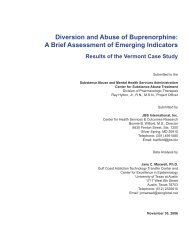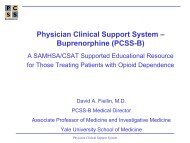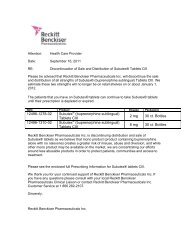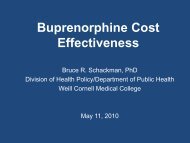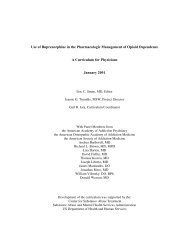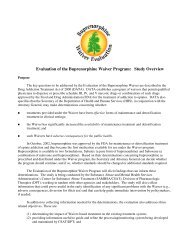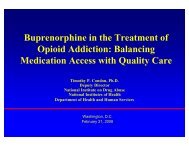Diversion and Abuse of Buprenorphine
Diversion and Abuse of Buprenorphine
Diversion and Abuse of Buprenorphine
You also want an ePaper? Increase the reach of your titles
YUMPU automatically turns print PDFs into web optimized ePapers that Google loves.
increasing, especially cases involving buprenorphine+naloxone. Overall, buprenorphine<br />
patients are younger than other opiate patients <strong>and</strong> are more likely to be referred to treatment or<br />
admitted to treatment directly from the ED, which could be an indication <strong>of</strong> a population that is<br />
self-medicating with buprenorphine <strong>and</strong> actively seeking treatment for their opioid dependence.<br />
Data from the DAWN Medical Examiner Reports. Unlike DAWN ED data, DAWN ME<br />
reports are representative only <strong>of</strong> the locale for which they are reported, <strong>and</strong> they cannot be used<br />
to draw nationwide conclusions. Data from medical examiners in Vermont, Maine, <strong>and</strong> New<br />
Hampshire are included in the 2003 DAWN Medical Examiner (ME) report.<br />
No buprenorphine deaths were reported in 2003 by any <strong>of</strong> the medical examiners in 122<br />
jurisdictions in 35 metropolitan areas <strong>and</strong> six States, but toxicological testing for buprenorphine<br />
requires a separate test. This test was not done by the medical examiners reporting the New<br />
Engl<strong>and</strong> cases <strong>and</strong> it may not be done on a routine basis elsewhere in the U.S.<br />
As shown in Exhibit 15, in 2003, the largest number <strong>of</strong> drug-related deaths in Maine <strong>and</strong> New<br />
Hampshire involved methadone, while the largest number in Vermont involved oxycodone.<br />
Fewer deaths involved heroin than methadone or oxycodone.<br />
Exhibit 15. Vermont, New Hampshire <strong>and</strong> Maine DAWN<br />
Medical Examiner Reports – Deaths Related to<br />
<strong>Buprenorphine</strong>, Methadone, Hydrocodone, Oxycodone<br />
or Heroin, 2003<br />
<strong>Buprenorphine</strong> Assessment: Final Report<br />
50<br />
45<br />
40<br />
35<br />
30<br />
25<br />
20<br />
15<br />
10<br />
5<br />
0<br />
3<br />
47<br />
24<br />
34<br />
7<br />
6<br />
0<br />
7<br />
19<br />
16<br />
12<br />
4<br />
8<br />
0<br />
0<br />
Maine New Hampshire Vermont<br />
*Special tests to identify buprenorphine were not run.<br />
Heroin<br />
Hydrocodone<br />
Methadone<br />
Oxycodone<br />
<strong>Buprenorphine</strong>*<br />
Source: SAMHSA Office <strong>of</strong> Applied Studies: Drug <strong>Abuse</strong> Warning Network, 2003.<br />
Findings: No buprenorphine deaths were reported in 2003 in Vermont or by any <strong>of</strong> the other 122<br />
reporting medical examiners in 35 metropolitan areas captured in the DAWN ME system.<br />
Toxicological testing for buprenorphine requires a separate test. It was not done by the medical<br />
examiners reporting the New Engl<strong>and</strong> cases <strong>and</strong> may not have been done on a regular basis by<br />
any medical examiner. This raises the possibility that buprenorphine deaths are being underreported.<br />
Toxicology Lab Reports. The National Forensic Laboratory Information System (NFLIS) is a<br />
Drug Enforcement Administration (DEA) program that systematically collects drug chemistry<br />
analysis results <strong>and</strong> other information from cases analyzed by State, local, <strong>and</strong> Federal forensic<br />
39




